

with the Great Oi River in the background.
in a dense forest.
Japan's most popular railfan destination with steam operations and an Abt rack rail system
 |
 |
|
A steam train on the Oigawa main line with the Great Oi River in the background. |
A mini train on the Ikawa line in a dense forest. |
General:
Oigawa Railway is a small regional railway in Shizuoka prefecture about 250km
southwest of Tokyo. It starts from Kanaya, a small town on the JR Tokaido
main line, and runs entirely along the great Oi river (Oi-gawa; gawa is river
in Japanese) through the Kawane district up to Ikawa, a village situated in a
sheer mountain area. There are no big cities nor heavy industries along the
line. It only serves small towns and villages sparsely located on the narrow
flat lands that lie along the river. However, the railway is special to
railfans with regularly operated steam trains and a mountain railway segment
that partly includes an Abt system (rack-rail system). This is why I am
introducing this regional railway here.
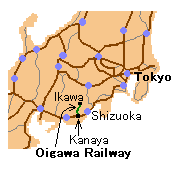 The Oi river, well known as one of the greatest rivers in Japan, flows about
180km down to the sea from a mountain range in Japanese Southern Alps, where
several 3000m-range mountains peak in a string. However, it is not necessarily
very long and its entire basin area is rather small in contrast to its fame.
The distinctive nature of the river is its isolation and wildness. Being
surrounded with precipitous mountains, the river and its valley areas are
almost isolated. To access the river from the east or west, there was no
means other than crossing over sheer mountains by overcoming rugged
passes. Also the river used to be pretty wild with rapid streams running
down along the steep river bed over rather short distances gathering water
from the deep rainy mountains. Before the modern era, this isolation and
wildness was taken advantage of by the Shognate to protect Edo (the old name
of Tokyo). No bridge was intentionally built over the river those days from a
strategic point of view. It could be a natural fortress along with the Hakone
Mountain range, which runs down from the Mt. Fuji area trough Izu Peninsula
to the sea. Travelers had to put up with hardships such as wading the river
and were often prevented from going through when the water level rose with
raging mudstreams, especially during rainy seasons. A famous song sang among
the horse men on the old Tokaido road was "32km long Hakone mountain path
could be overcome by a horse ride, but no way to cross the wild Oi."
The Oi river, well known as one of the greatest rivers in Japan, flows about
180km down to the sea from a mountain range in Japanese Southern Alps, where
several 3000m-range mountains peak in a string. However, it is not necessarily
very long and its entire basin area is rather small in contrast to its fame.
The distinctive nature of the river is its isolation and wildness. Being
surrounded with precipitous mountains, the river and its valley areas are
almost isolated. To access the river from the east or west, there was no
means other than crossing over sheer mountains by overcoming rugged
passes. Also the river used to be pretty wild with rapid streams running
down along the steep river bed over rather short distances gathering water
from the deep rainy mountains. Before the modern era, this isolation and
wildness was taken advantage of by the Shognate to protect Edo (the old name
of Tokyo). No bridge was intentionally built over the river those days from a
strategic point of view. It could be a natural fortress along with the Hakone
Mountain range, which runs down from the Mt. Fuji area trough Izu Peninsula
to the sea. Travelers had to put up with hardships such as wading the river
and were often prevented from going through when the water level rose with
raging mudstreams, especially during rainy seasons. A famous song sang among
the horse men on the old Tokaido road was "32km long Hakone mountain path
could be overcome by a horse ride, but no way to cross the wild Oi."
The Oigawa railway line looks like one line on a map. However, it is
actually split into two different lines at Senzu terminal, a lower segment
and an upper segment. The lower segment is the Oigawa main line, between
Kanaya and Senzu, while the upper segment is the Ikawa line, between Senzu
and Ikawa, with both having equal 39.5km trackage. Both are all single track
with 1,067mm (3'6'') narrow gauge. The Oigawa main line is 1500VDC electrified,
while the Ikawa line is non-electrified except on the rack rail section which
is powered with 1500VDC. Although both lines use the same gauge, rolling
stock on the Oigawa line cannot enter the upper segment because of the
smaller-sized allowable clearance of the Ikawa line.
History of the Oigawa railway:
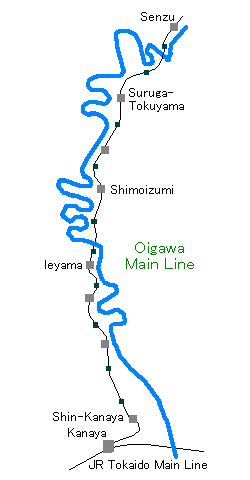 The Oigawa Railway Company originated in 1925. The role of the railway
was to transport logs and to develop hydroelectric power plants
along the river. It was around the era just after World War I and the Great
Kanto Quake when the economy boomed, bringing about a sharp growth of the
prefecture's logging industry, and electricity companies were targeting the
river's secluded area for hydroelectric power sources because of the
ample rainfall in the Oi river area.
The Oigawa Railway Company originated in 1925. The role of the railway
was to transport logs and to develop hydroelectric power plants
along the river. It was around the era just after World War I and the Great
Kanto Quake when the economy boomed, bringing about a sharp growth of the
prefecture's logging industry, and electricity companies were targeting the
river's secluded area for hydroelectric power sources because of the
ample rainfall in the Oi river area.
The Oigawa line's first segment opened in 1923, followed by the
inauguration of full service over the entire trackage in 1926. Due to the
commencement of rail service, the life of the people in the deep Oi area
drastically changed. Before that, horse riding across sheer passes, rafts and
ships, were the only transport means for the people.
The rail service started with steam hauled mixed trains. Later, diesel
rail cars were introduced. In 1949 after World War II, the line was
entirely electrified on 1500VDC. In 1951, passenger trains were replaced
with EMUs.
The upper segment of the Ikawa line is the successor of an old logging
railway, which also was dedicated to freight transportation for dam
construction. More detailed information of the Ikawa line history will be
described in the next page.
Both line's freight transportation roles finished when the construction of
the Ikawa Dam, the greatest dam in the Oi river water system, had been
completed, and the logging industry shifted its transportation mode to
trucks. Now, the railway serves as a sightseeing railway for tourists who
visit scenic canyons, hot spring spas and artificial lakes in the deep
Oigaw region. Also the Oigawa railway is one of the most common railfan
destinations with steam operations and the mini trains on the Ikawa line
along with the attractive scenery on all the way to Ikawa.
Steam Operation:
The Oigawa Railway revived steam trains in 1976, the year after all
steam locomotives were displaced on the national railway lines. Since then,
it has been operating steam trains on the Oigawa main line between Kanaya and
Senzu with a fleet of four steam engines, all of which were restored by the
Oigwa Railway. Another attraction of the railway's steam operations is
its old coaches. Their dark maroon livery is as when they used to be in old
steam days when they were dominant all over Japan.
The railway's current steam train operations are one daily round trip
(except January 1st) and one or two additional round trips during weekends
and busy tourist seasons. The daily train starts Kanaya at 11:50 and arrives
in Senzu at 13:07. The return trip leaves Senzu at 14:50 and arriving in
Kanaya at 16:09.
Steam Locomotive Roster
| In working order | |
|---|---|
 C11-227 (2-6-4 tank), 66.1 tons, built in 1942 |
 C11-312 (2-6-4 tank), 66.1 tons, built in 1948 |
 C12-164 (2-6-2 tank), 50.1 tons, built in 1937 |
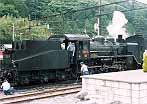 C56-44 (4-6-0), 37,6 tons, built in 1935 |
| In static exhibition | |
|---|---|
 C10-8 (2-6-4 tank) 69.7 tons, built in 1930 |
 49616 (2-8-0) 95 tons, built in 1920 |
Two small locomotives are in static exhibition in a railway archive in front
of Shin-Kanaya station. They are 1275, built in Germany in 1922, and SL
Izumo, built in Germany in 1921.
 |
 |
| Inside the station on the sidings are old coaches, and some old-looking electric locomotives in use for switching work. | The steam train pulled in with the leading engine of C11312 |
The steam train pulled in with the leading engine of C11312, a 2-6-4
tank. The formation was four old coaches. Thank goodness, no head mark was
decorated on the front of the engine, and no special car was added. The
coaches were Type Oha 35s sandwiched between Type Ohafu 33s, both of which
are pre-war types. The tapered ends of these cars with end vestibules are a
typical feature of coaches from those days. The train really appeared to be an
authentic old steam-hauled passenger train.
 |
 |
| The tapered ends of these cars with end vestibules are a typical feature of coaches from those days. | Inside, the coach retained its old wooden interior with cross seats and the wooden floor. |
.
The train proceeded through the town of Kanaya for a while, but soon entered a
rural area. A rice field was stretching along the track, as far as the
foothill of the mountain which actually looked close. Reaching the
foothill, outside the view transformed in a moment into that of a rugged
mountain area. Then, the train began taking a narrow path cut into the
bank that steeply falls down to the river. As the train rolled along the
path ascending the grade, the great Oi river came in view through woods below
the track.
The wide river bed seen was almost all sand and rocks, with some narrow
streams flowing separately. The Oi river used to be so wild enough with
ample water flow and sometimes flooded the fields stretching down to the
Shimada area, which is across the river from Kanaya. From around 1900,
the river improvement work started and later a number of dams were
consecutively built at the middle and upstream reaches, so it became calm.
Now, the water flow on the river is under human control, so people have all
forgotten the fear of flooding that had afflicted them for a long time.
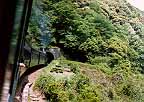 |
| The train sometimes entered tunnels when it hit the flanks of the mountain that reached down to the river. |
 |
| The river bed of the great Oi could be seen just downward of the windows. |
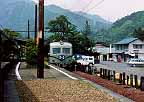 |
| Another train met at Shimoizumi was a 2-car streamlined Zoom Car, MO 21001 class, purchased from Nankai Electric Railway in Osaka. |
After passing Suruga-Tokuyama loop, the river began forming sharp S
curves again. The railway ran straight crossing bridges and through
tunnels. As soon as it emerged from the last tunnel on the line, the
train crossed the final bridge and regained the western bank. The river now
became considerably narrower, situated upstream of the sharp S curves. The
train arrived in Senzu terminal on time. It was a one hour and seventeen
minutes ride.
Senzu station is a 4-track terminus with two island platforms along with a
number of sidings. On some sidings were some items of preserved railway
heritage. Static exhibits include steam engines, a down quadrant 2-aspect
semaphore, a Britain-made turntable, etc. In the steam locomotive archive
located adjacent to the station are various collections and items that
explicitly tell the history of this railway. The manual block signaling
machines which used to be in use a long time ago on the line were
fantastic.
Oigawa Railway Main Line Photos